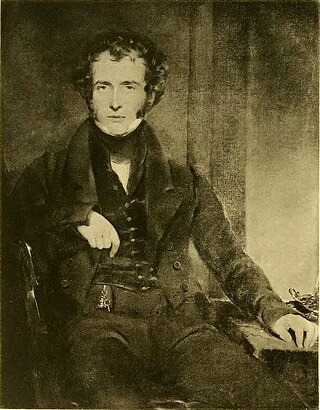Related Research Articles

Marquess of the County of Bute, shortened in general usage to Marquess of Bute, is a title in the Peerage of Great Britain. It was created in 1796 for John Stuart, 4th Earl of Bute.

Marquess of Linlithgow, in the County of Linlithgow or West Lothian, is a title in the Peerage of the United Kingdom. It was created on 23 October 1902 for John Hope, 7th Earl of Hopetoun. The current holder of the title is Adrian Hope.

Earl of Dumfries is a title in the Peerage of Scotland. It was originally created for William Crichton, 9th Lord Crichton of Sanquhar, in 1633, and stayed in the Crichton family until the death of the fourth countess in 1742, at which point the title passed to first the Dalrymple and then the MacDouall families before finally being inherited by the Marquesses of Bute, where it remains today.

Earl of Galloway is a title in the Peerage of Scotland. It was created in 1623 for Alexander Stewart, 1st Lord Garlies, with remainder to his heirs male bearing the name and arms of Stewart. He had already been created Lord Garlies in the Peerage of Scotland in 1607, with remainder to the heirs male of his body succeeding to the estates of Garlies. This branch of the Stewart family were distant relatives of the Stewart Kings of Scotland.

Earl of Annandale and Hartfell is a title in the Peerage of Scotland, created in 1661 for James Johnstone.

Earl of Stair is a title in the Peerage of Scotland. It was created in 1703 for the lawyer and statesman John Dalrymple, 2nd Viscount of Stair.

William Johnstone, 2nd Earl of Annandale and Hartfell, 1st Marquess of Annandale KT was a Scottish nobleman. He was the son of James Johnstone, 1st Earl of Annandale and Hartfell and Henrietta Douglas. He succeeded to the Earldom of Annandale and Hartfell on the death of his father in 1672.

Clan Johnstone is a Border Reiver Scottish clan.

John Hope, 2nd Earl of Hopetoun was a Scottish aristocrat.
Lt.-General Godfrey Bosville Macdonald, 3rd Baron Macdonald of Sleat was a Scottish aristocrat.

James Hope-Johnstone, 3rd Earl of Hopetoun FRSE was a Scottish peer, politician and military officer.

James Johnstone, 3rd Earl of Annandale and Hartfell and 2nd Marquess of Annandale (c.1687–1730) was a Scottish art collector and politician who sat in the British House of Commons briefly in 1708 before being disqualified as eldest son of a Scottish peer.
Percy Wentworth Hope-Johnstone was a British Army officer, de jure 10th Earl of Annandale and Hartfell.

John James Hope-Johnstone of Annandale DL was a Scottish Tory politician.
James Johnstone may refer to:

The Corrie family, also known as the Currie family, was a Scottish family which was once seated in what is today the civil parish of Hutton and Corrie, in Annandale, Dumfriesshire, Scotland. The leading branch of the family were the Corries of that Ilk. Members of the family are on record in the Middle Ages. The family held numerous lands, but lost the lands from which they derived their surname, with the marriage of an heiress, sometime during the reign of James V, King of Scots.
Hope-Johnstone is a surname. Notable people with the surname include:
William Lindsay, 18th Earl of Crawford and 2nd Earl of Lindsay was a Scottish noble and politician.

John Lindsay, 17th Earl of Crawford, 1st Earl of Lindsay was a Scottish nobleman.
Arthur Henry Johnstone-Douglas JP DL was a Scottish soldier and politician.
References
- 1 2 3 Montague-Smith, Patrick W., ed. (2008). "Annandale and Hartfell, Earl of (Johnstone of Annandale and that Ilk) (Earl S by Charter 1662 with precedence 1643)". Debrett's Peerage and Baronetage 2008. London: Debrett's Peerage Limited.
- 1 2 3 Winter, Laura, ed. (2016). "Annandale and Hartfell, Patrick Andrew Wentworth Hope Johnstone of Annandale and of that Ilk 11 Earl of (S, by Charter, 1662)". Debrett's People of Today 2016. London: Debrett's Peerage Limited.
